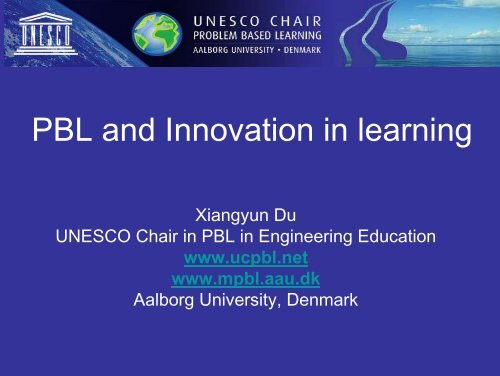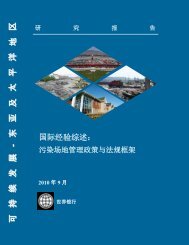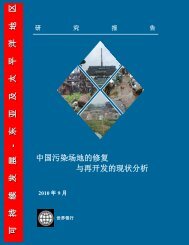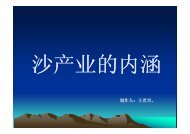PBL and Innovation in learning
PBL and Innovation in learning
PBL and Innovation in learning
- No tags were found...
You also want an ePaper? Increase the reach of your titles
YUMPU automatically turns print PDFs into web optimized ePapers that Google loves.
<strong>PBL</strong> <strong>and</strong> <strong>Innovation</strong> <strong>in</strong> learn<strong>in</strong>gXiangyun DuUNESCO Chair <strong>in</strong> <strong>PBL</strong> <strong>in</strong> Eng<strong>in</strong>eer<strong>in</strong>g Educationwww.ucpbl.netwww.mpbl.aau.dkAalborg University, Denmark
Agenda• Why change <strong>and</strong> <strong>in</strong>novation• What– <strong>PBL</strong> as an stratergy• Aalborg <strong>PBL</strong> model
Aalborg at the Fjord – 160,000 <strong>in</strong>habitants
Aalborg UniversityEstablished 197414,000 Students, 1200 Faculty StaffFaculty ofEng<strong>in</strong>eer<strong>in</strong>g, Science, Medic<strong>in</strong>e6,000 StudentsDepartment ofFaculty ofSocial Science4,500 StudentsDepartment of• Civil Eng<strong>in</strong>eer<strong>in</strong>g• Social Studies &• Build<strong>in</strong>g Technology & OrganisationStructural Eng<strong>in</strong>eer<strong>in</strong>g • Economics, Politics <strong>and</strong>• Chemistry <strong>and</strong> Applied Public Adm<strong>in</strong>istrationEng<strong>in</strong>eer<strong>in</strong>g Science• Bus<strong>in</strong>ess Studies• Electronic Systems• Production• Physics• Energy Technology• Mechanical Eng<strong>in</strong>eer<strong>in</strong>g• Computer Science• Mathematical Science• Life Sciences• Architecture <strong>and</strong> Design• Development <strong>and</strong> Plann<strong>in</strong>g• Health Science <strong>and</strong> TechnologyFaculty ofHumanities3,500 StudentsDepartment of• History, International,<strong>and</strong> Social Studies• Music <strong>and</strong> Music Therapy• Communication• Languages <strong>and</strong>International studies
The General Structure of University Studies3 + 2 + 3Doctor level4. Ph.D. thesis – three yearsMaster level3. Second specialisation – two yearsBachelor level2. First Specialisation – two years1. Basic study Year – one year
viarise from resonant or focus<strong>in</strong>g eects.In the third part, FDTD is benchmarked for well dened antenna congurations<strong>and</strong> applied to electromagnetic eld prediction of a variety ofantenna near-eld con-gurations. With<strong>in</strong> the rst study, potential diculties from simulat<strong>in</strong>g transmitters<strong>in</strong> the closest proximity of lossy scatterers were <strong>in</strong>vestigated. For this purpose a geometrically<strong>and</strong> electrically well-dened generic phone was developed <strong>and</strong> analyzed<strong>in</strong> free space <strong>and</strong> close to a lossy phantom <strong>in</strong> the far- <strong>and</strong> near-eld. The resultsshowed that FDTD is highly suitable with high accuracy for well dened antennacongurations <strong>in</strong> the close proximity of lossy scatterers.In a second study, a specic Crawford TEM cell exposure setup was analyzed thathad already been utilized for bio-experiments but could not previously be characterizedwith respect to the exposure. The results of this study not only had signicantimpact on the <strong>in</strong>terpretation of these bio-experiments but also on a series of otherexperiments which were scheduled to be conducted <strong>in</strong> TEM cells. It was discoveredthat the exposure homogeneity as well as the eciency were much lower than orig<strong>in</strong>allyanticipated. This was the start<strong>in</strong>g po<strong>in</strong>t for the proposal <strong>and</strong> analysis of avariety of other exposure setups better suited for <strong>in</strong> vitro bio-experiments.In a third study, a caroussel exposure setup used for <strong>in</strong> vivo bio-experiments wasanalyzed <strong>and</strong> optimized with respect to its eciency. For the rst time, the performanceof an <strong>in</strong> vivo exposure setup was analyzed <strong>in</strong> great detail us<strong>in</strong>g high resolutionMRI data of animals, <strong>in</strong>clud<strong>in</strong>g experimentally validated SAR distributions <strong>in</strong> theanimal bra<strong>in</strong>s.Thanks to this <strong>in</strong>itial experience <strong>and</strong> the unique comb<strong>in</strong>ation of the availabilityof both the most advanced numerical <strong>and</strong> experimental tools, the group currentlyevaluates, optimizes <strong>and</strong> develops <strong>in</strong> vitro <strong>and</strong> <strong>in</strong> vivo exposure setups for variouslaboratories throughout the world.The last study documented <strong>in</strong> this thesis is an application of FDTD for an issuewhich was also driven by an urgent request from outside, namely by the US FederalCommunications Commission (FCC). It addresses the question of ear exposure dur<strong>in</strong>gusage of a mobile phone. This issue was brought up <strong>in</strong> a legal conict s<strong>in</strong>ce it is relatedto the question of correct ear model<strong>in</strong>g for test<strong>in</strong>g compliance with safety guidel<strong>in</strong>esfor electromagnetic exposure. The study was an excellent test for the developed codes<strong>in</strong>ce it required the use of a phantom with better resolution than had ever been usedbefore <strong>and</strong> with arbitrarily oriented phone positions.All applications have been thoroughly validated with either an <strong>in</strong>dependent numericaltechnique, experimental <strong>in</strong>vestigations or us<strong>in</strong>g both approaches.
Why change: Challenges for the curriculaStudent’s own<strong>in</strong>terestIn TRADITIONAL learn<strong>in</strong>genvironmentWhat the student canlearn with<strong>in</strong> a given timeBorder of presently“known” knowledgeExpected skillsfrom <strong>in</strong>dustrySocial & globalresponsibilitiesBorder of “new”knowledge - everexp<strong>and</strong><strong>in</strong>g
Why Change: overfed students
Why change: Requirements from AccreditationEffectivecommunicationTeam workApplication ofmathematics <strong>and</strong>science knowledgeProjectmanagementGlobalized contextInterdiscipl<strong>in</strong>aryknowledgeAnalytical skillsDiversecapabilitiesLifelong learn<strong>in</strong>gDesign<strong>in</strong>g <strong>and</strong>conduct<strong>in</strong>gexperimentsIdentity <strong>and</strong> solveapplied scienceproblemsSocial,environmental, <strong>and</strong>ethical concernsInterculturalcompetencies- National Academy of Eng<strong>in</strong>eer<strong>in</strong>g, The Eng<strong>in</strong>eer of 2020, 2004- EUR-ACE (Accreditation of European Eng<strong>in</strong>eer<strong>in</strong>g Programmes <strong>and</strong> Graduates,http://www.feani.org/EUR_ACE/EUR_ACE_Ma<strong>in</strong>_Page.htm- ABET: http://www.abet.org/
Why change: Requirements from Accreditation1.2.3.4.5.6.First CyclegraduateIndividual <strong>and</strong>Team workCommunicationThe Eng<strong>in</strong>eerAnd SocietyEthicsEnvironment<strong>and</strong>Susta<strong>in</strong>abilityProjectManagement<strong>and</strong> F<strong>in</strong>anceEUR-ACE: Personal Programme Outcomes forthe bachelor levelFunction effectively as an <strong>in</strong>dividual, <strong>and</strong> as a member or leader <strong>in</strong> diverseEng<strong>in</strong>eer<strong>in</strong>g teams.Communicate effectively on <strong>in</strong>termediate eng<strong>in</strong>eer<strong>in</strong>g activities with theeng<strong>in</strong>eer<strong>in</strong>g community <strong>and</strong> with society at large, by be<strong>in</strong>g able tocomprehend <strong>and</strong> write effective reports <strong>and</strong> design documentation, makeeffective presentations, <strong>and</strong> give <strong>and</strong> receive clear <strong>in</strong>structionsDemonstrate underst<strong>and</strong><strong>in</strong>g of the societal, health, safety, legal <strong>and</strong> culturalissues <strong>and</strong> the consequent responsibilities relevant to eng<strong>in</strong>eer<strong>in</strong>g practice.Underst<strong>and</strong> <strong>and</strong> commit to professional ethics <strong>and</strong> responsibilities <strong>and</strong> normsof eng<strong>in</strong>eer<strong>in</strong>g practice.Underst<strong>and</strong> the impact of eng<strong>in</strong>eer<strong>in</strong>g solutions <strong>in</strong> a societal context <strong>and</strong>demonstrate knowledge of <strong>and</strong> need for susta<strong>in</strong>able development.Demonstrate an awareness <strong>and</strong> underst<strong>and</strong><strong>in</strong>g of management <strong>and</strong> bus<strong>in</strong>esspractices, such as risk <strong>and</strong> change management, <strong>and</strong> underst<strong>and</strong> their limitations.
Why change: expectation from <strong>in</strong>dustryComparaison of capabilities taught at universities <strong>and</strong>required <strong>in</strong> professional life by young profesionals - Germany(Becker 2006)
Why change: expectation from <strong>in</strong>dustryRank<strong>in</strong>g of capabilities important <strong>in</strong> professional life by youngelectrical eng<strong>in</strong>eers five years after graduation - Germany
Why Change: Susta<strong>in</strong>able development for HECortese 2003
Trend of change:From content to competency drivenContent <strong>and</strong>methodsOutcomesObjectivesOutcomesObjectivesContent <strong>and</strong>methods
Teach<strong>in</strong>g =Learn<strong>in</strong>g?“Teach<strong>in</strong>g does not meantransferr<strong>in</strong>g knowledge butcreat<strong>in</strong>g opportunities forlearn<strong>in</strong>g…produc<strong>in</strong>g <strong>and</strong>construct<strong>in</strong>g it.” (Paulo Freire)(Karl Smith, UMN)
Educational changes <strong>in</strong> Denmark• New study programs: enrichedeng<strong>in</strong>eer<strong>in</strong>g discipl<strong>in</strong>es• New expectations: broadened eng<strong>in</strong>eer<strong>in</strong>gskills <strong>and</strong> competences• New study forms: implement<strong>in</strong>g studentcentred <strong>and</strong> work place-imitated learn<strong>in</strong>genvironment (for example, <strong>PBL</strong> as aneducational strategy)New challenges <strong>and</strong> tasks for educators
<strong>PBL</strong> as a strategy for changecMaster 1968aastricht 1972nkop<strong>in</strong>g 1972oskilde 72lborg 74roblems as focus <strong>and</strong> stimulus for learn<strong>in</strong>gelf directed learn<strong>in</strong>gtudent-centred <strong>and</strong> tutors as facilitators/guideseam work• Problem orientation• Interdiscipl<strong>in</strong>arity• Exemplary learn<strong>in</strong>g• Participant directed
<strong>PBL</strong> Aalborg Model50%coursesProjectcourses 7,5ECTSStudy courses7,5 ECTSOnesemester50%projectProject 15ECTSGroupexam<strong>in</strong>ationIndividualexam<strong>in</strong>ationModel from The Aalborg <strong>PBL</strong> model - Progress, Diversity <strong>and</strong> ChallengesAnette Kolmos, Flemm<strong>in</strong>g K. F<strong>in</strong>k & Lone Krogh1 ECTS (European Credit Transfer System) = 30 work<strong>in</strong>g hours
<strong>PBL</strong> Aalborg Model: Pr<strong>in</strong>ciples‘The Aalborg Experiment – project <strong>in</strong>novation <strong>in</strong>university education’ - Kjaersdam & Enemark (1994)
Group formation:(by students based on <strong>in</strong>terest)Each group a project roomGroup size: 6-8 1st year4-5 middle years, 2-3 later yearsProblemProjectTeam workProblemanalysisProblem Solv<strong>in</strong>g + Report writ<strong>in</strong>g <strong>in</strong> groupExamTheme - frameworkEach group 1-2 facilitatorLecturesLiteratureExperimentCompaniesOther experts
Learn<strong>in</strong>g goals,Knowledgeshar<strong>in</strong>g,Collaboration,Peer learn<strong>in</strong>g
Project management<strong>and</strong> plann<strong>in</strong>g
Status sem<strong>in</strong>arsPresentation,FeedbackReflectionProgression
Diversity – discipl<strong>in</strong>e <strong>and</strong> group aspect‘It is so excit<strong>in</strong>g to work on this, wesolve problems <strong>and</strong> we see th<strong>in</strong>gshappen…’ - Students from EE‘It is bor<strong>in</strong>g to only focus on technicalth<strong>in</strong>gs… I don’t want to become nerdsby study<strong>in</strong>g eng<strong>in</strong>eer<strong>in</strong>g. I want to workwith technology <strong>in</strong> a creative way <strong>and</strong>to do someth<strong>in</strong>g for people…’- Students from A&D
Diversity of physical facilitation
Role of teach<strong>in</strong>g <strong>in</strong> <strong>PBL</strong> – situated facilitationell<strong>in</strong>g students what they shouldearn <strong>and</strong> <strong>in</strong> what sequence theyhould learn itAn example of Aalborg UniversityHelp<strong>in</strong>g students determ<strong>in</strong>e on theirown what they need to know <strong>and</strong> howthey need to learn itBarrow & Tamblyn 1980eklyeCoursesProjectSemester time (app. 5 months)fore:ann<strong>in</strong>gojectoposals <strong>and</strong>oject coursesBeg<strong>in</strong>n<strong>in</strong>g:• More direct guidance• Literature, theories, methods• Contacts with companies• PotentialsDur<strong>in</strong>g the process:• Consultancy• Comments• Monitor<strong>in</strong>gEnd:Assess<strong>in</strong>g
acilitation <strong>and</strong> group dynamics
Structure - MSc, Environmental Management
1st semester, Company focus
Semester 1Company PerspectiveSemester 2Social & Institutional PerspectiveSemester 3Tra<strong>in</strong>eeship; alternatively EnvironmentalAssessmentCourses (examples)Corporate EnvironmentalManagement; Feasibility Studies;Organisational Theory; ResearchMethodologyTheories of Science; Policy,Institutions <strong>and</strong> Discourses; EIA,Politics of Susta<strong>in</strong>able Development;Technology Transfer, EnvironmentalGovernance & Policy Instruments,International <strong>and</strong> EU Green PoliciesEnvironmental Assessment; StrategicImpact Assessment, Cost-BenefitAnalysisSemester 4Master ThesisNo courses
International Master Program of Environmental ManagementSemester 1 ThemeCompany perspective – Environmental management <strong>in</strong>dustries <strong>and</strong>cleaner production <strong>and</strong> productsProject focusIn-depth analysis of a company’s environmental strategies <strong>and</strong>performance <strong>and</strong> suggests improvements <strong>in</strong> relation to productionprocesses, the product life cycle, or management policies. At the end ofthe semester, a project report is submitted, present<strong>in</strong>g relevant theories<strong>and</strong> an analysis of the case study.CoursesFeasibility Studies 2 ECTSResearch Methodology 2 ECTSOrganisation Theory 1 ECTSApproaches to environmental problem solv<strong>in</strong>g 2 ECTSIntroduction to Energy Systems 1 ECTSSusta<strong>in</strong>able Energy Systems Analyses 2 ECTSFundamental Investment Theory <strong>and</strong> Excel 1 ECTS
oup 1: The Green Mart<strong>in</strong> Projects (group 1 report)ontextnd aimsesearchuestionheoriesesearchethodsesultsMart<strong>in</strong> Professional, a producer of <strong>in</strong>telligent light<strong>in</strong>g systems seeks to develop agreen profile. This project seeks to identify the aspects of Mart<strong>in</strong>’s activities <strong>and</strong>products that impact the environment as well as the gaps exist<strong>in</strong>g betweenMart<strong>in</strong>’s present environmental work <strong>and</strong> the ISO 14001 requirements.What are the gaps between the current environmental work of Mart<strong>in</strong> Professional<strong>and</strong> the ISO 14001 st<strong>and</strong>ards <strong>and</strong> what are the potentials <strong>and</strong> barriers for reduc<strong>in</strong>ghe significant environmental impacts of the company’s activities <strong>and</strong> products?The step model, Environmental Management Systems (EMS),• Qualitative approach for data generation – <strong>in</strong>terviews with the company’srepresentatives, on-site tour of the company, literature review of relevantmaterials from <strong>in</strong>ternet sources, scientific journals.• Analysis of <strong>in</strong>terview, Analysis of selected products by Sima Pro tool,Analysis of gap analysis questionnaires.Mart<strong>in</strong>’s activities impact the environment adversely predom<strong>in</strong>antly through thefactory’s total energy <strong>in</strong>put, emissions to air <strong>and</strong> even most importantly throughthe energy consumed <strong>in</strong> the use stage of the products. Other less significantenvironmental impacts identified related to hazards, waste, water consumption<strong>and</strong> nuisances. Compared to the ISO 14001 requirements, the company was foundto possess an environmental policy, <strong>and</strong> had also done some work <strong>in</strong> relation tooperational control <strong>and</strong> emergency preparedness <strong>and</strong> response. It however fell
Group 3: Environmental Impacts of Passive Houses (group 3 report)Context <strong>and</strong>aimsResearchquestionTheoriesResearchmethodsResultsTo determ<strong>in</strong>e how significant the choice of materials is when design<strong>in</strong>genergy-efficient houses <strong>in</strong> relation to their lifecycle environmentalimpacts.Controll<strong>in</strong>g for energy efficiency <strong>and</strong> design, what are the estimated costs <strong>and</strong>environmental impacts related to two energy-efficient houses, conceived<strong>in</strong> accordance with either a susta<strong>in</strong>able development or an energyefficiency criteria?Life cycle th<strong>in</strong>k<strong>in</strong>g, susta<strong>in</strong>able development <strong>and</strong> construction, passive house,passive <strong>and</strong> active systems, big bale build<strong>in</strong>g, LS/EPS Passive house• Case study, <strong>in</strong>terviews• Costs analysis, life cycle assessmentThe construction costs were the most persuasive element of the partial results.The BBB is significantly less expensive to construct. The use stageshowed an important f<strong>in</strong>ancial dom<strong>in</strong>ance over the two other stages. Theglobal warm<strong>in</strong>g category revealed itself to be the most important featureto consider among the environmental categories selected <strong>in</strong> this study, <strong>and</strong>at a lesser degree nutrient enrichment. The choice <strong>in</strong> the materials is ofgreat importance of the other stages especially <strong>in</strong> relation to the embodiedenergy due to transport which formed an important feature <strong>in</strong> LS/EPS
Evidence – students learn<strong>in</strong>gMotivation <strong>and</strong> engagementDeep learn<strong>in</strong>gSelf-directed learn<strong>in</strong>gCriticality of learnersProfessional Skills improvementProcess skillsInterdiscipl<strong>in</strong>ary knowledge <strong>and</strong> skillsCreativity <strong>and</strong> design<strong>in</strong>g skillsProfessional identity <strong>and</strong>responsibilitySelf-satisfaction <strong>and</strong> mean<strong>in</strong>gfullnessGraff <strong>and</strong> Cowdroy 1997, Thomas 2000,Kolmos <strong>and</strong> Du, 2006Biggs 2003Du 2006aSav<strong>in</strong>-Baden 2003Dochy et al 2001, Frenay et al 2007Kolmos 1996, 1999, Du 2006, Kolmos <strong>and</strong>Du 2006, Croshwaite, 2006Kjaersdam 1994, Graaff <strong>and</strong> Kolmos 2003Schrøder 2006Hmelo <strong>and</strong> Evensen 2000, Kolmos 2006, Du2006a, 2006bSav<strong>in</strong>-Baden 2000, Du 2006a
ATe alborgUn chnicalU niversity iversity(A ofDenma AU) rk(DTU)Pr oject<strong>and</strong> peoplem anageme nt419 86Q ualityofe ng<strong>in</strong>er<strong>in</strong> g<strong>and</strong>tec hnicalski ls85C ontact<strong>and</strong> work<strong>in</strong>g relations to<strong>in</strong>dust ry5081In novative <strong>and</strong>creati veskils8136 59K nowledge ofbus<strong>in</strong>e s-lifean d-econo my 18O veralqua lityofedu cation7 87 4Percen tageofresp ondentsjud g<strong>in</strong>gtheca ndidates'skils<strong>in</strong> Source thevariou :Nyhedsm sdiscipl<strong>in</strong>e agas<strong>in</strong>etI sas"god" en,nngenir13,204 or"verygoAal Tec borgU hnical nivers Unive ity(A rsityo U) fDenm ark(D TU)P roject <strong>and</strong>p eople manag ement419 8 6Q uality ofeng <strong>in</strong>eri ng<strong>and</strong> techn icalsk ils8 5C ontac t<strong>and</strong>w ork<strong>in</strong> grelat ionsto <strong>in</strong>dus try5081I nova tivean dcrea tivesk ils8136 5 9K nowle dgeo fbus<strong>in</strong> es-li fe<strong>and</strong> -econ omy18O veral lqualit yofed ucatio n8747P ercenta geofre sponden tsjudg <strong>in</strong>gthe c<strong>and</strong>ida tes'skSo ils<strong>in</strong>t urce: Nyheds hevario magas usdisc <strong>in</strong>etIn ipl<strong>in</strong>es geni as"go n,nr1 d"or"v erygo 3,204Evaluation from Danish <strong>in</strong>dustry on graduatesAalborg University (AAU)Technical University of Denmark (DTU)Project <strong>and</strong> people management941Quality of eng<strong>in</strong>eer<strong>in</strong>g <strong>and</strong> technical skills8685Contact <strong>and</strong> work<strong>in</strong>g relations to <strong>in</strong>dustry5081Innovative <strong>and</strong> creative skills5981Knowledge of bus<strong>in</strong>ess -life <strong>and</strong> -economy1836Overall quality of education7487Percentage of respondents judg<strong>in</strong>g the c<strong>and</strong>idates'skills <strong>in</strong> the various discipl<strong>in</strong>es as "good" or "very good"Source: Nyhedsmagas<strong>in</strong>et Ingenien, nr 13, 2004
<strong>PBL</strong> – Regional development<strong>PBL</strong> AAU as a good example of l<strong>in</strong>k<strong>in</strong>g students with thelocal economy (OECD 2007, Puukka <strong>and</strong> Marmolejo2008)– Students benefit from• Ga<strong>in</strong><strong>in</strong>g transferable skills <strong>and</strong> authentic work experiences– University benefits from• ga<strong>in</strong><strong>in</strong>g feedback <strong>and</strong> access to <strong>in</strong>structive cases <strong>and</strong> ideasfor research <strong>and</strong> teach<strong>in</strong>g• Improv<strong>in</strong>g graduate retention• Higher rate on-time f<strong>in</strong>ish<strong>in</strong>g ( AAU 87% v.s 38% others <strong>in</strong>DK)• Lower drop-out rate (AAU lowest <strong>in</strong> DK)• Improved <strong>in</strong>terdiscipl<strong>in</strong>ary collaboration among teach<strong>in</strong>g staff– Enterprises benefit from• A clearer picture of what the university st<strong>and</strong>s for <strong>and</strong> how thestudents might fit <strong>in</strong> as prospective employees
A walk around AAU Ma<strong>in</strong> Campus






